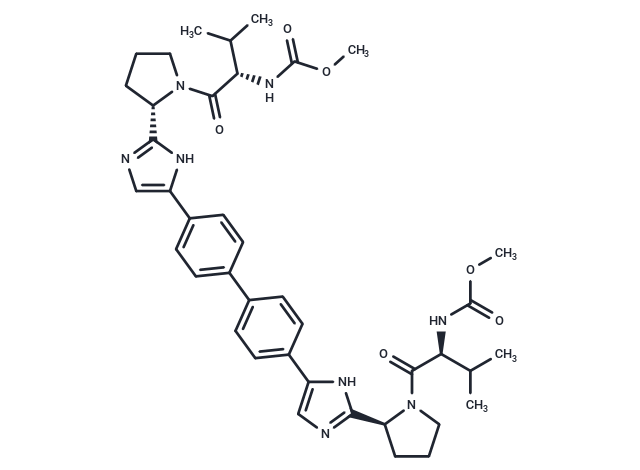购物车
- 全部删除
 您的购物车当前为空
您的购物车当前为空

Daclatasvir (EBP 883) 是一种高度选择性的 HCV NS5A 抑制剂,EC50 为 9-50 pM,适用于细胞培养中的多种 HCV 复制子基因型和 JFH-1 基因型 2a 感染性病毒。

Daclatasvir (EBP 883) 是一种高度选择性的 HCV NS5A 抑制剂,EC50 为 9-50 pM,适用于细胞培养中的多种 HCV 复制子基因型和 JFH-1 基因型 2a 感染性病毒。
| 规格 | 价格 | 库存 | 数量 |
|---|---|---|---|
| 1 mg | ¥ 223 | 现货 | |
| 5 mg | ¥ 497 | 现货 | |
| 10 mg | ¥ 756 | 现货 | |
| 25 mg | ¥ 1,560 | 现货 | |
| 50 mg | ¥ 3,110 | 现货 | |
| 100 mg | ¥ 4,560 | 期货 | |
| 200 mg | ¥ 6,490 | 期货 | |
| 1 mL x 10 mM (in DMSO) | ¥ 635 | 现货 |
| 产品描述 | Daclatasvir (EBP 883) (BMS-790052) is a highly selective inhibitor of HCV NS5A with EC50 of 9-50 pM, for a broad range of HCV replicon genotypes and the JFH-1 genotype 2a infectious virus in cell culture. Phase 3. |
| 靶点活性 | HCV NS5A:9 pM-50 pM(EC50) |
| 体外活性 | Daclatasvir是迄今为止报道中的高效 HCV复制抑制剂。对于HCV基因型1a和1b复制子,Daclatasvir的平均EC50值分别为50和9pM。Daclatasvir显示出至少105的治疗指数(CC50/EC50),并且对于一组10种RNA和DNA病毒无效,其EC50值高于10μM,这证实了Daclatasvir对HCV的特异性。[1]在含有HCV基因型1b复制子的Huh7细胞中,Daclatasvir能够阻断HCV基因组的瞬时和稳定复制,EC50值范围从1-15 pM不等。100 pM或1 nM的Daclatasvir已显示出能改变NS5A的亚细胞定位和生化分级。[2]Daclatasvir抑制含有HCV基因型-4 NS5A基因的杂交复制子,EC50为7-13 pM。在杂交复制子中,NS5A的第30残基是Daclatasvir介导的抗性的一个重要位点。[3] |
| 体内活性 | 在一项随机、双盲、安慰剂对照的单次递增剂量研究中,Daclatasvir (BMS-790052) 以口服溶液形式,按六个剂量级别给予健康的非HCV感染受试者,剂量范围从1到200mg。Daclatasvir在高达200mg的剂量下安全且耐受良好,无临床相关不良反应。口服后,Daclatasvir迅速被吸收,暴露量与剂量成比例,且所有受试者在给药后24小时及以后的化合物浓度均高于基于蛋白质结合调整的EC90(针对基因型1a和1b,通过复制体测定法测量)[1]。小鼠分为两组进行治疗,一组接受Asunaprevir/Daclatasvir治疗4周,另一组接受Ledipasvir/GS-558093治疗4周。Asunaprevir/Daclatasvir和Ledipasvir/GS-558093治疗能迅速降低血清HCV RNA水平至灵敏度以下,除Ledipasvir/GS-558093组的两只小鼠外,治疗完成后未检测到病毒[5]。 |
| 激酶实验 | FRET assay for HCV NS5A inhibitors: The peptide (Ac-Asp-Glu-Asp [EDANS]-Glu-Glu-Abu-[COO] Ala-Ser-Lys [DABCYL]-NH2) contains a fluorescence donor {EDANS, 5-[(2-aminoethyl)amino]naphthalene-1-sulfonic acid} near one end of the peptide and an acceptor {DABCYL, 4-[(4-dimethylamino)phenyl]azo)benzoic acid} near the other end. Intermolecular resonance energy transfer between the donor and the acceptor quenches the fluorescence of the peptide, but as the NS3 protease cleaves the peptide, the products are released from resonance energy transfer quenching. The fluorescence of the donor increases over time as more substrate is cleaved by the NS3 protease. The assay reagent is: 5× luciferase cell culture lysis reagent diluted to 1× with dWater, NaCl (150 mM), the FRET peptide (20 μM). HCV-Huh-7 cells are placed in a 96-well plate, and allowed to attach overnight (1×104 cells per well). The next day, BMS-790052 is added to the wells and the plate is incubated for 72 hours. The plate is then rinsed with PBS and used for the FRET assay by the addition of 30 μL of the FRET peptide assay reagent (described above) per well. Signals are obtained using the Cytofluor 4000 instrument, which has been set to 340 nm (excitation)/490 nm (emission) automatic mode, for 20 cycles or less, with the plate being read in the kinetic mode. Following FRET, 40 μL of luciferase substrate is added to each well and the luciferase is measured. |
| 细胞实验 | BMS-790052 is added to 96-well plates containing HCV replicon cells seeded approximately 12?hours before in 200 μL media.The cell plates are tested for replication activity and cytotoxicity after 72 hours of incubation. Cytotoxicity is measured with CellTiter-Blue, after which the media and dye are removed, plates are inverted and the remaining liquid is blotted with paper towels. Replication activity of the HCV genotype 1a cell lines is quantified using Renilla luciferase. 1× Renilla luciferase lysis buffer (30 μL) is added to each well and plates are incubated with gentle shaking for 15?min. Renilla luciferase substrate (40 μL) is then added and the signals are detected using a Top Count luminometer set for light emission quantification. One hundred per cent activity is calculated for each cell line for the DMSO-only wells; percentage activity is calculated for each concentration of the inhibitor by dividing the average value for wells containing compound by the average value for wells containing DMSO.(Only for Reference) |
| 别名 | 达拉他韦, 达卡他韦, EBP 883, Daklinza, BMS-790052 |
| 分子量 | 738.88 |
| 分子式 | C40H50N8O6 |
| CAS No. | 1009119-64-5 |
| Smiles | COC(=O)N[C@@H](C(C)C)C(=O)N1CCC[C@H]1c1ncc([nH]1)-c1ccc(cc1)-c1ccc(cc1)-c1cnc([nH]1)[C@@H]1CCCN1C(=O)[C@@H](NC(=O)OC)C(C)C |
| 密度 | 1.249 |
| 存储 | Powder: -20°C for 3 years | In solvent: -80°C for 1 year | Shipping with blue ice. | |||||||||||||||||||||||||||||||||||
| 溶解度信息 | H2O: < 1 mg/mL (insoluble or slightly soluble) DMSO: 136 mg/mL (184.06 mM), Sonication is recommended. Ethanol: 136 mg/mL (184.06 mM), Sonication is recommended. | |||||||||||||||||||||||||||||||||||
溶液配制表 | ||||||||||||||||||||||||||||||||||||
DMSO/Ethanol
| ||||||||||||||||||||||||||||||||||||
评论内容